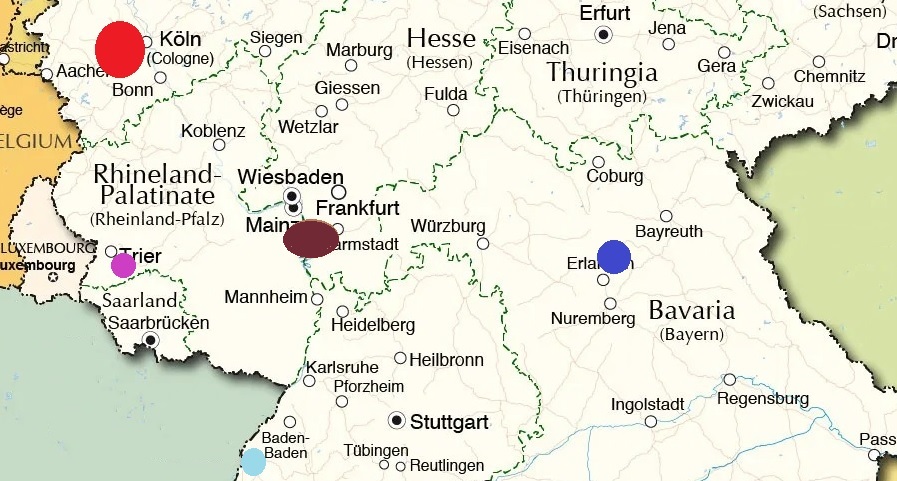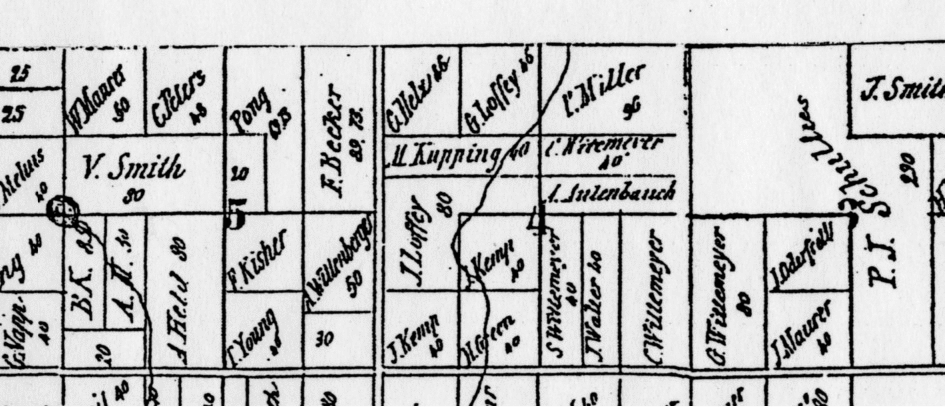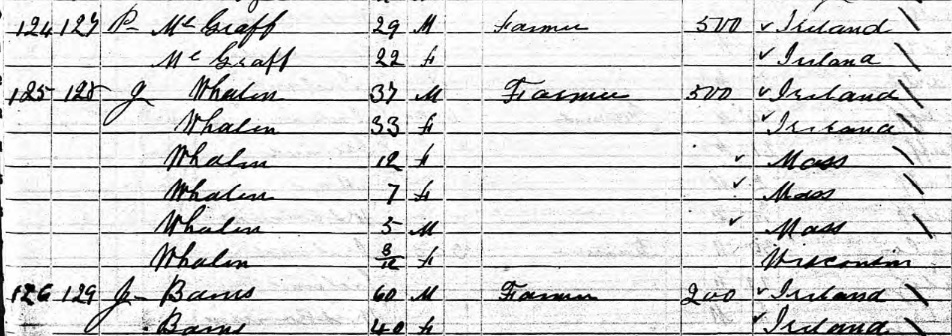Click here to go to my home page.
Please feel free to email me or call my landline with any questions.

Wisconsin Genealogy - Presentation by John Von Haden - Summer, 2021
© 2000-2021 by John Von Haden All rights reserved.
Welcome to my 'Fun with Census and Plat Maps' presentation.
Click here to go to my home page.
Please feel free to email me or call my landline with any questions.
While much of the details of this presentation are specific to Washington and Ozaukee counties (which were one county until 1852), the lessons learned might help with later censuses in counties all over the state... for instance, if you cannot find your family in the 1880 census in Chippewa county even though you are certain they lived there at the time.
The proliferation of searchable census databases has made some of this a moot point. However, there are still some needles in the haystack to be found that even online indexes and soundexes don't help with. The case which follows of a lazy census taker is an interesting example.
Let me take you back forty five years to 1976 when I started doing genealogy, before online genealogy, back to the days when you searched the census on a microfilm reader page by page looking for your family.
One of my lines goes back to Nicholas and Angela Wagner of the town of Polk. I knew they were in Wisconsin before 1850, but could not find them in the 1850 census in the town of Polk. From land records, I later learned that they previously owned a farm about a mile south in the town of Richfield from 1846 to 1854. So then I searched in the town of Richfield.
Only one family came close... with the surname 'Wagoner'.
But I expected the children's names to be Anna, Peter, John, Nicholas, Martin and Elizabeth.
So I assumed this was a different family and the census taker had simply missed my ancestor's household.
Twenty years later...
After living in Minnesota for 10 years with the genealogy on hold, my wife and I moved back to Wisconsin and I restarted my obsession. A few years later, a fellow working on his thesis named Helmut Schmahl from Oppenheim, Hessen contacted me. He was researching the hundreds of families who flocked from his vicinity to Washington county, Wisconsin in the 1840's. He needed some data, so I went to the courthouse in West Bend and got all of the purchase dates and legal descriptions of farms in the southeastern part of Washington county.
Now also having this data myself, I wrote software to draw the farms in the order they were purchased and color coded based on where they came from. I find the results fascinating.
|
Purchases primarily in September to November 1842 During 1842, in the northeast, Lutherans from Hessen (in brown), a solitary Catholic family (Franz Joseph Stuesser) from the Rheinland (in red), plus one Yankee William Ostrander (in gray), a land speculator in New York bought farms. |
Purchases thru November 1843 During 1843, more Hessian Lutherans bought farms in the northeast with some from Bavaria (in blue) and more Irish farmers bought farms in the southwest. |
|||||||||||||||||||||||||||||||||||||||||||||||||||||||||||||||||||||||||||||||||||||||||||||||||||||||||||||||||||||||||||||||||||||||||||||||||||||||
|
Purchases thru November 1844 During 1844, while Irish and Hessians arrive, joined by some from Bavaria (in blue) and more from the Rheinland (in light purple). |
Purchases over the next eight years By the early 1850's, all of the land had been purchased, including section 16, initially reserved for the school district. |
|||||||||||||||||||||||||||||||||||||||||||||||||||||||||||||||||||||||||||||||||||||||||||||||||||||||||||||||||||||||||||||||||||||||||||||||||||||||
|
The map to the right shows approximately from where the 1840's groups of German families emmigrated. It's worth noting just how small these vicinities were... about 25 miles in diameter for the two largest... Rheinland and Hessen. |

|
By this time, I had worked at the State Historical Society in Madison during college and recently began renting dozens of microfilms at a local LDS research center. I had found records in Germany for my Wagner ancestors and completed extensive research of both the Lutheran and Catholic families in the town of Richfield.
Then plat maps gave me a new idea. I decided to revisit the 1850 census, but this time I did so while looking at the 1859 plat map and my computer generated maps.
I started with that Wagoner entry and went three households in both directions, finding those farmers on the plat map. Below is the list of heads of those households.
|
Household # and Head of household #312 = N. Smith #313 = M. Petus #314 = P. Bong #315 = N. Wagoner #316 = Peter Roser #317 = John Lawfer #318 = P. Shultis |
I edited the image below to only show the heads of households. |
I drew lines between farms each time the census taker went to the next household. A couple of farms had since changed hands... the Wagner farm had been sold to Friedrich Becker and the Rosar farm had been sold to his son-in-law, Charles Hoelz. Imagine walking with the census taker down the road that August day in 1850...

That 'Wagoner' family was my family !!
A side by side complarison shows that except for the first names, the ages, genders and birth places were very accurate.
| Expected name | Age | Gender | Birthplace | Enumerated name | Age | Gender | Birthplace |
| Nicholas Wagner | 43 | m | Germany | N. Wagoner | 44 | m | Germany |
| Angela (or Anna) | 43 | f | Germany | M. | 43 | f | Germany |
| Anna | 17 | f | Germany | Dorathy | 17 | f | Germany |
| Peter | 14 | m | Germany | Samuel | 13 | m | Germany |
| John | 11 | m | Germany | George | 11 | m | Germany |
| Nicholas | 8 | m | Germany | John | 9 | m | Germany |
| Martin | 4 | m | New York | Nicholas | 5 | m | New York |
| Elizabeth | 1 | f | Wisconsin | Mary | 2 | f | Wisconsin |
I was excited to share this information with my friend Mary, whose Lofy ancestors lived near mine, attending the same church. They appear in my example above as the slightly misspelled John 'Lawfer' family. Mary also thought that her Lofy family was missing from the 1850 census, even though she suspected they should be there.
Here is the side by side comparison for the Lofy family.
| Expected name | Age | Gender | Birthplace | Enumerated name | Age | Gender | Birthplace |
| John Joseph Lofy | 29 | m | Germany | John Lawfer | 29 | m | Germany |
| Maria Anna | 24 | f | Germany | M. | 24 | f | Germany |
| John | 1 | m | Wisconsin | James | 1 | m | Wisconsin |
| Catharine | 67 | f | Germany | C. | 70 | f | Germany |
In this case, both the surname and family member's name were off just enough that it never caught her eye when scanning page by page. An exciting part for Mary was to learn where the matriarch of the Lofy family lived in 1850. Catharine could have been living in Milwaukee with another son, but this census discovery finally answered the question!
It gets worse...
About the same time in my research, another lady for whom I had been doing some professional research in the Hubertus area wrote saying, 'John, I think I found my family in the 1850 census, but the first names of the children are all wrong... What do you make of that?'. Over the next few weeks I came to the realization that EVERY SINGLE household in the town of Richfield for 1850 has this problem.
I shared my findings with other genealogists. They would say 'But John, you have to realize that the census taker couldn't understand German and that some children went by their middle names'. However, I was still confident because (a) all of the Irish families around Lake Five have the same problem, and (b) I had seen civil birth records and baptisms in Hessen, Baden and Rheinland for these families so I knew many of these children had no middle names.
My suspicion...
I suspect the census taker, out of laziness, went to each farm and aside from the farmer himself, the census taker only filled in the columns for the age, gender and birthplace (which are quite accurate throughout) for the rest of the family. At some ponit, he must have learned that to get paid, he needed first names. But it would take weeks to revisit hundreds of households, so he just sat down and one by one filled in first names... Dorathy for a female, next one Samuel for a male, next one George for a male, next one Betsy for a female, and so on... completely fabricating all of the first names.
And then...
As time passed, I had been transcribing all of Washington and Ozaukee county censuses alongside plat maps. One evening while working on the town of Erin, my wife heard me exclaim out loud, 'Oh, nooo...' when I realized that the names of children were also wrong. I looked at the top of the census page and sure enough, there was his name !!
Seeing the last four pages of the town of Erin gave credibility to my suspicion... all first names are missing on those four pages.

He got away without finishing making up names on the last four pages!
This census taker lived in Port Washington, up to 45 miles away from some townships so he didn't personally know the communities. He enumerated six townships... Erin, Richfield, Hartford, Polk, Mequon, Grafton... plus helped out in Port Washington where he lived. It took almost three months...
July 31 - Aug. 6, 1850 = Erin
Aug. 7 - Aug. 19, 1850 = Richfield
Aug. 19 - Aug. 30, 1850 = Hartford
Sep. 2 - Sep. 30, 1850 = Polk (except Sep. 10-13 when he appears on some Port Washington pages)
Sep. 30 - Oct. 19, 1850 = Mequon
Oct. 19 - Oct. 24, 1850 = Grafton
Only Erin and Richfield have the first names problem, so he must have learned his lesson about the time he finished Richfield.
More errors in 1850...
By studying an entire county (which subsequently split into two) with decades of research, I have learned that there are entire pages of the 1850 Washington county census which are mislabeled as the WRONG township, resulting in
It's not plausible that tens of families (all next to each other in the 1850 census) sold their farms and collectively picked up and moved to the same alternate township.
I suspect the large books holding the 1850 census were copied from hundreds of individual sheets turned in by the census takers. The sheets must have gotten mixed up in order, and if the census taker didn't always write the township at the top, when they were copied into books (bound copy now at the State Historical Society), the transriber became confused as to which township some of the pages belonged to.
The impact...
I now recognize when I see...
It's not the researcher's fault... The cause is these issues with the 1850 Washington County census.
Some very badly misspelled surnames...
It doesn't take long for genealogists to realize how often surnames are spelled incorrectly in early censuses. Online indexes are quite good at helping you locate your family anyway, but sometimes it takes a little more digging. The census/platmap appoach helped with a some of these.
| Farmer | Actual Surname | Census | Thoughts |
| Jacob Anton Kratz |
Kratz | misspelled as | Cronch | This is one of my ancestors, as an example of the most common case of a census taker just spelling what he heard. |
| Casper Weifenbach |
Weifenbach | misspelled as | Nuninbar | One which the soundex cannot help. The census taker likely wrote what he heard and spelled it 'Weivenbach' but when transcribed into the official book, then when transcribed into the official book, Weivenbach looked like Nuninbar. |
| Gottlieb Walrabenstein |
Walrabenstein | misspelled as | Rusatine | Same regarding soundex. Perhaps the census taker didn't hear the 'Wal' and/or his notes were somewhat unreadable to the transcriber. |
| Heinrich Gabriel Kurtz |
Kurtz | misspelled as | Gabenaurz | Same regarding soundex. This one mashed his middle name into the surname. |
| Hubert Johannes |
Johannes | listed as | Johannes Hooper |
The first and last names were reveresed AND then Hubert ended up as Hooper. |
| Peter (and John) Schwartz |
Schwartz | listed as | Black | Someone (census taker or transcriber) decided to do us a 'favor' and change Schwartz to its English equivalent 'Black'. However, Neither of these brothers ever once appear on any church record, land deed, news story, tombstone, etc... under the surname Black. |
Conclusion:
Some notes about the Irish...
Some notes about the Hessians...
Miscellaneous notes about Catholics from the Rheinland and Bavaria...